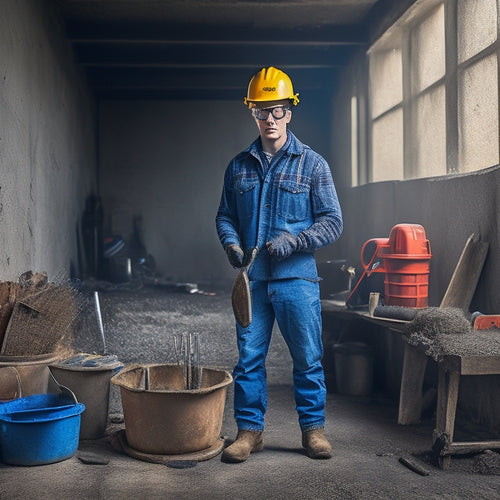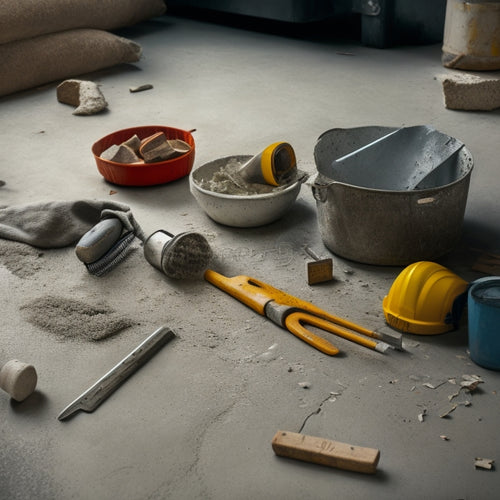
5 Best Tools for Painting Concrete Block Walls
Share
When painting concrete block walls, you'll need the right tools for a professional-looking finish. Start with a paint roller suited for thick, porous blocks, and use the right brush for cutting in, like an angled sash brush for baseboards or a detail brush for small areas. Smooth out the surface with an orbital sander or hand sander, and clean the wall with a pressure washer before applying a sealant. Finish with the right applicator, like a roller for acrylic or a spray for polyurethane. Now that you've got the basics covered, get ready to tackle the specifics of each tool to achieve a flawless finish.
Key Takeaways
• Choose the right paint roller with a longer nap length for thick, textured paints and shorter nap length for smoother paints.
• Select essential brushes, such as angled sash, flat, round, and detail brushes, for cutting in and mastering various techniques.
• Use sanding tools like orbital, belt, and hand sanders with progressive grits to smooth out the surface.
• Clean the concrete block wall with a pressure washer, using a wide fan tip and gentle sweep to avoid damage.
• Apply sealants like acrylic, polyurethane, silane, siloxane, or epoxy using rollers, brushes, or sprayers for a durable finish.
Selecting the Right Paint Roller
When tackling a concrete block wall painting project, choosing the right paint roller is essential because it can make a significant difference in the final result's appearance and durability.
You'll want to select a roller that can handle the thick, porous nature of concrete blocks. There are several roller types to take into account, each suited for specific paint thicknesses.
For thick, textured paints, you'll need a roller with a longer nap length (around 1-2 inches) to guarantee good coverage. For smoother paints, a shorter nap length (around 1/4 inch) will do the trick.
Microfiber rollers are also an excellent option, as they produce a smooth finish and can handle a variety of paint thicknesses. Regardless of the roller type, make sure it's designed for concrete block walls and can withstand the rigors of painting rough surfaces.
Essential Brushes for Cutting In
With your paint roller selected, you'll need to complement it with the right brushes for cutting in, as these will help you achieve sharp, clean lines around edges, corners, and any areas where the roller can't reach.
When it comes to cutting in, you'll want to master various cutting techniques to get the best results. The right brush types can make all the difference.
Here are the essential brushes you'll need:
-
Angled sash brush: Ideal for cutting in along baseboards, windows, and doors, these brushes have angled bristles that allow for precise control.
-
Flat brush: Use these for cutting in along straight edges, such as ceiling lines or wall corners.
-
Round brush: Perfect for getting into tight spaces, like around pipes or electrical outlets.
- Detail brush: These small, fine-bristled brushes are great for painting small areas, like trim or molding.
Smoothening With Sanding Tools
You'll need to prepare your concrete block walls for painting by smoothing out their rough surfaces, and that's where sanding tools come in. To achieve a smooth finish, you'll need to master various sanding techniques and choose the right grit selection for the job.
| Sanding Tool | Grit Range | Recommended Use |
|---|---|---|
| Orbital Sander | 80-120 | Removing old paint and rough surfaces |
| Belt Sander | 120-150 | Smoothing out large areas quickly |
| Hand Sander | 220-240 | Finishing and polishing small areas |
When selecting a grit, remember that lower numbers are coarser and higher numbers are finer. Start with a coarse grit to remove imperfections, then progress to finer grits for a smoother finish. Don't forget to work in small, circular motions and apply gentle to moderate pressure, depending on the tool and surface. By combining the right sanding techniques with the right grit selection, you'll be able to achieve a silky-smooth surface that's ready for painting.
Cleaning With Pressure Washer
After sanding, remove any remaining dust and debris by blasting your concrete block walls with a pressure washer to create a clean canvas for painting. You'll want to choose the right pressure washer type for the job - electric or gas-powered, depending on the size of your wall and the level of dirt buildup. When using a pressure washer, always maintain a safe distance from the wall to avoid damaging the concrete.
Here are some key cleaning techniques to keep in mind:
-
Start with a wide fan tip to cover large areas quickly, then switch to a narrower tip for more precision.
-
Work from the bottom up to prevent dirt and grime from running down the wall.
-
Use a wide, gentle sweep to clean the wall, rather than a concentrated stream that can damage the concrete.
- Test the pressure washer on a small, inconspicuous area first to verify you're not using too much force.
Finishing With Sealant Applicators
Once your walls are clean and dry, apply a concrete sealant to protect the surface and guarantee a durable, long-lasting finish. You'll need to choose the right sealant type and application technique for your specific project.
| Sealant Type | Application Technique |
|---|---|
| Acrylic | Roller or brush for a matte finish |
| Polyurethane | Spray for a high-gloss finish |
| Silane | Low-pressure spray for a natural look |
| Siloxane | High-pressure spray for a durable barrier |
| Epoxy | Brush or roller for a chemical-resistant finish |
When applying sealant, make certain to follow the manufacturer's instructions and take necessary safety precautions. Work in well-ventilated areas, and use protective gear like gloves and masks. Apply the sealant in thin, even coats, allowing each coat to dry completely before applying the next. This will guarantee a strong, uniform bond between the sealant and the concrete. With the right sealant and application technique, you'll be able to enjoy a beautiful, long-lasting finish for your concrete block walls.
Frequently Asked Questions
Can I Paint Concrete Block Walls in Cold Weather Conditions?
When you're planning to paint concrete block walls, you'll need to take into account the cold weather conditions.
If it's too chilly, paint adhesion challenges arise, and your finish won't last. You should ideally paint when temperatures are between 50°F and 90°F (10°C and 32°C).
If you can't wait, make certain the surface is dry, clean, and free of ice or frost. Even then, be prepared for potentially slower drying times and reduced paint performance.
How Do I Remove Efflorescence Before Painting?
You'll need to tackle efflorescence removal before painting.
Start by scrubbing the affected areas with a stiff brush and a mixture of trisodium phosphate (TSP) and warm water.
For tougher cases, use a more aggressive cleaning solution like muriatic acid, but be sure to wear protective gear and follow safety guidelines.
Rinse thoroughly and let dry before applying a primer or paint.
Will Painting Concrete Block Walls Reduce Their Strength?
You're probably wondering if painting concrete block walls will compromise their strength. Coincidentally, I've seen many homeowners ask themselves the same question.
Rest assured, a well-applied coat of paint won't greatly impact the wall's structural integrity. In fact, painting can enhance durability and make wall maintenance easier.
Can I Use Epoxy Paint on Concrete Block Walls?
You're considering epoxy paint for your concrete block walls, but can you really use it? Absolutely!
Epoxy paint offers advantages like durability and chemical resistance. However, you'll need to prioritize surface preparation to guarantee a strong bond.
Clean the walls thoroughly, fill any cracks, and etch the surface to create a rough texture.
With proper prep, epoxy paint will adhere beautifully, providing a long-lasting finish that withstands harsh conditions.
Do I Need to Prime Concrete Block Walls Before Painting?
You're about to reveal the secret to a flawless finish on your concrete block walls.
Before you immerse yourself in painting, ask yourself: do I need to prime? The answer is a resounding yes!
Proper priming techniques will guarantee a strong bond between the paint and wall.
It's essential to choose a primer specifically designed for concrete, and consider your paint selection - some epoxy paints can be used without primer, but it's still recommended for best results.
Conclusion
You've made it to the final coat!
Research suggests that a well-painted concrete block wall can increase a property's value by up to 10%.
With the right tools, you've not only boosted your home's curb appeal but also invested in its resale value.
By mastering the tools outlined in this article, you'll be well on your way to a professional-looking finish that will last for years to come.
Related Posts
-

What Tools Do I Need for Concrete Wall Repair
As you prepare for a concrete wall repair job, you'll need a variety of tools to guarantee a successful outcome. Star...
-

Top 10 Concrete Repair Tools for Small Fixes
You'll need the right tools to tackle small concrete repairs efficiently and effectively. When it comes to small fixe...
-

Best Tools for Concrete Restoration and Repair
When tackling concrete restoration and repair projects, you need a range of reliable tools to achieve professional-gr...


